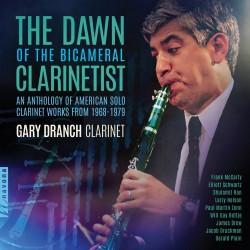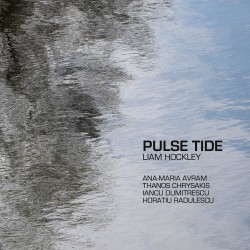 The Dawn of the Bicameral Clarinetist
The Dawn of the Bicameral Clarinetist
Gary Dranch
Navona Records nv6693 (navonarecords.com/catalog/nv6693)
Pulse-Tide
Liam Hockley
Aural Terrains (liamhockley.bandcamp.com/album/pulse-tide)
What have we done with music? We didn’t invent it, but we have certainly messed around with it. Music is a way we have of organizing sound (I owe John Cage a beer); sound is pervasive, even maddeningly so. No wonder humans take stimuli and organize them, visually or sonically, even kinetically, and often all at once.
Such deep thoughts help me cope with my own prejudices, especially my dislikes, when it comes to assessing the discs I have before me. The Dawn of the Bicameral Clarinetist is a survey of works for solo clarinet and electronic media, dating between 1968 and 1979, by composers whose names may be familiar to those who pay attention to this type of art. Comprehensive accompanying notes about performers, composers as well as performance dates, fill out the story. Clarinetist Gary Dranch demonstrates commitment and virtuosity in service of this niche (one decade, all clarinet, plus or minus electronics), or as he puts it, “time capsule.” It’s interesting, even fascinating. My aesthetic sense is rewarded, and my skepticism about the value of such a retrospective is forced to sit in the back and listen.
By preference I gravitate to the traditional form of James Drew’s St. Dennis Variations, the most recent work with the most ancient roots. Dranch is an expressive and able player; these recordings may sound a bit raw but it’s because they were initially recorded live on cassette tape! Talk about ancient.
 More up-to-date, and yet less satisfying in terms of recording quality, is Liam Hockley’s Pulse Tide. The B.C.-based Hockley performs spectral works for the hound of the clarinet family, the basset horn. Ana-Maria Avram exploits the wolf-ish tone of this somewhat balky beast in Penumbra. Hockley produces a hypnotic, ASMR-inducing quality from a series of multiphonics, flutter and slap tonguing, key clicks and vibrato-laden micro melodies. The dry recording environment sponges up any reverb, which works in a way and seems artificial at the same time; room-bounce has been sponged up.
More up-to-date, and yet less satisfying in terms of recording quality, is Liam Hockley’s Pulse Tide. The B.C.-based Hockley performs spectral works for the hound of the clarinet family, the basset horn. Ana-Maria Avram exploits the wolf-ish tone of this somewhat balky beast in Penumbra. Hockley produces a hypnotic, ASMR-inducing quality from a series of multiphonics, flutter and slap tonguing, key clicks and vibrato-laden micro melodies. The dry recording environment sponges up any reverb, which works in a way and seems artificial at the same time; room-bounce has been sponged up.
Artifice also characterizes the charming Egress, by Thanos Chrysakis. An overlay of five tracks all played by Hockley. What an oddity, a humoresque of argumentative fowl.
Next, Hockley plays un-self-accompanied, i.e. solo, in Aura by Iancu Dumitrescu. I have trouble connecting the title to the series of new-music-y effects. A second listen might have been in order, but life is, after all, short. On content, I think 75% is a good average, and who can account for other tastes than one’s own?
In contrast, Horatiu Radulescu’s Capricorn’s Nostalgic Crickets, is the capper at 25+ minutes. Not content to provide a mere five voices, Hockley here plays seven overlay tracks. I wonder whether a Basset choir (pack?) would be possible in practical terms (few owner-operators, fewer gigs). In this incarnation it’s not easy to discern separate parts, or whether he overlayed the same material seven times, the overlap generating the interest. Imagine a slow repeated kind of organic instrumental respiration. This one is the oldest work by more than two decades. It serves, like Avram’s, to induce a meditative Beta state. The crickets are certainly extra-terrestrial, but benign. Perhaps they’re angels? Give this track time and space, it’s the coolest.



